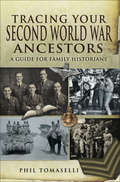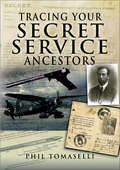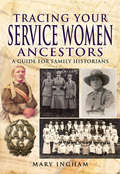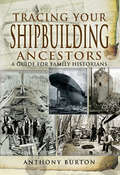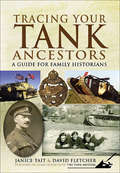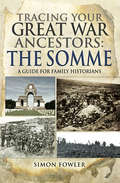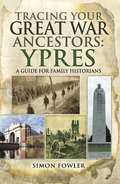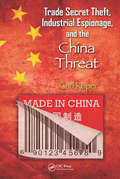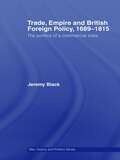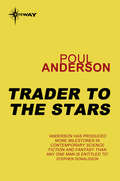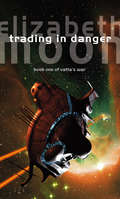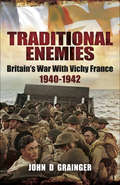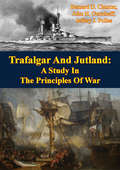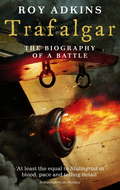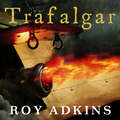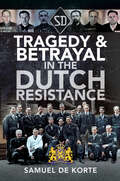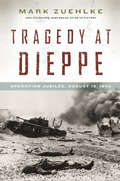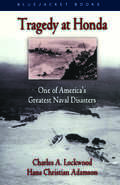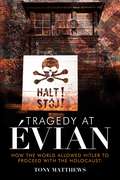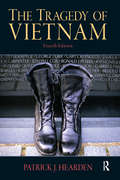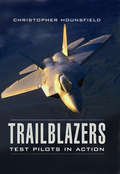- Table View
- List View
Tracing Your Second World War Ancestors (Tracing Your Ancestors)
by Phil TomaselliThe Second World War was the defining conflict of the twentieth century and it is one of the most popular and fascinating areas for historical research and for family historians. More records than ever are available to researchers whose relatives served during the war. And this new book by Phil Tomaselli is the perfect guide to how to locate and understand these sources and get the most out of them. He explains how, and from where, service records can be obtained, using real examples showing what they look like and how to interpret them. He also examines records of the military units relatives might have served in so their careers can be followed in graphic detail. The three armed services are covered, along with the merchant navy, the Home Guard, civilian services, prisoners of war, gallantry and campaign medals, casualties, womens services and obscure wartime organizations. Also included are a glossary of service acronyms, information on useful websites, an introduction to the National Archives and details of other useful sources.
Tracing Your Secret Service Ancestors (Tracing Your Ancestors)
by Phil TomaselliDid you have a spy in the family, an ancestor who was involved in espionage at home or abroad? If you have ever had any suspicions about the secret activities of your relatives, or are curious about the long hidden history of Britain's secret services and those who served in them, this is the book for you. Phil Tomaselli's fascinating guide to over 200 years of British spies and spying takes the reader on a journey through the twilight world of the secret intelligence organizations Britain has run since the time of the French Revolution to the modern day, and it shows where their records can be found.
Tracing Your Service Women Ancestors: A Guide for Family Historians (Tracing Your Ancestors)
by Mary InghamWhether you are interested in the career of an individual service woman or just want to know more about the part played by service women in a particular war or campaign, this is the book for you. Assuming that the reader has no prior knowledge of service women, Mary Ingham explains which records survive, where they can be found and how they can help in your research. She also vividly describes the role of women with the armed services from the Crimean War of the 1850s to the aftermath of the First World War and offers an insight into what the records can tell you about the career of an ancestor who served at home or abroad. From the army schoolmistresses to the Womens Land Army, her account outlines the history of each service, describes uniforms and gives examples of daily life and likely experiences. This is the book you need if you want to follow up those clues in your familys history stories heard from older relatives, pictures in family photograph albums, handed-down uniforms, badges or medals that seem to indicate that one of your women ancestors served in wartime.
Tracing Your Shipbuilding Ancestors: A Guide For Family Historians (Tracing Your Ancestors)
by Anthony BurtonAnthony Burton's concise and informative guide to British shipbuilding will be absorbing reading for anyone who wants to learn about its history or find out about the life of a shipbuilder and his family. In a clear and accessible way he traces its development from the medieval period to its peak in the nineteenth and early twentieth centuries and on into the present day. He describes how, at the height of its powers, it was of immense importance. It employed tens of thousands of workers, so a large proportion of the population today has some connection with it. And this great industry was also so widespread that wherever you move around the coast of Britain, you will never be far from a former shipbuilding center.This practical handbook will be an invaluable guide for family and local historians and for readers with a more general interest in shipbuilding. It introduces the variety of national and local records that are available for genealogical research and considers the many other resources that can yield fascinating information about the industry and those who worked in it.
Tracing Your Shipbuilding Ancestors: A Guide For Family Historians (Tracing Your Ancestors)
by Anthony BurtonAnthony Burton's concise and informative guide to British shipbuilding will be absorbing reading for anyone who wants to learn about its history or find out about the life of a shipbuilder and his family. In a clear and accessible way he traces its development from the medieval period to its peak in the nineteenth and early twentieth centuries and on into the present day. He describes how, at the height of its powers, it was of immense importance. It employed tens of thousands of workers, so a large proportion of the population today has some connection with it. And this great industry was also so widespread that wherever you move around the coast of Britain, you will never be far from a former shipbuilding center.This practical handbook will be an invaluable guide for family and local historians and for readers with a more general interest in shipbuilding. It introduces the variety of national and local records that are available for genealogical research and considers the many other resources that can yield fascinating information about the industry and those who worked in it.
Tracing Your Tank Ancestors: A Guide for Family Historians (Tracing Your Ancestors)
by David Fletcher Janice TaitIf you want to find out about the career of a soldier who served in tanks, are researching medals awarded to a tank crew member or just want to know more about a particular regiment squadron or operation, this book will point you in the right direction.Assuming that the reader has little prior knowledge of the history of British armored forces, Janice Tait and David Fletcher trace their development from their formation during WW1, through WWII and on to their role as an essential part of today's British army. Most importantly, they demonstrate how you can explore this history for yourself. The authors describe the records that are available and show how they can help you to reconstruct the career of a soldier who served in tanks or was connected with them. They also describe the kind of work the soldiers did, the armored vehicles they worked with, and the men and women they served alongsideThis accessible, information-packed introduction to the history of British armored forces will be essential reading and reference for anyone who is researching this aspect of military history.
Tracing your Great War Ancestors: A Guide for Family Historians (Tracing Your Ancestors)
by Simon FowlerIf you want to find out about an ancestor who served on the Somme during the First World War during the Battle of the Somme in 1916 or at any time during the fighting in this sector of the Western Front this book is the ideal guide. It provides practical information and advice on how to conduct your research. It will help you to discover when and where your ancestors served and give you an insight into his experience of the war. It is also a fascinating introduction to researching the Great War as a whole.Simon Fowler outlines the course of the fighting on the Somme, introducing the many historical resources that you can use to explore the history for yourself. He identifies the key sources for family historians, including at The National Archives and Imperial War Museum and the many online sites that researchers can turn to. There is also advice on the literature, archives, museums and monuments that may help you to gain an insight into your ancestor's story.
Tracing your Great War Ancestors: A Guide for Family Historians (Tracing Your Ancestors)
by Simon FowlerDo you have an ancestor who served at Ypres in the First World War, during the four years in which the city was in the front line? Perhaps you have thought of visiting the battlefields nearby and the monuments that commemorate them, and want to find out exactly where your ancestor served and what part he played in the four great battles that took place there?So many British soldiers served in Flanders during the long struggle to defend the Ypres Salient and to break out of it that there is a good chance that your ancestor was there at some stage of the war. This practical and informative handbook is an ideal guide to the struggle for the city and the stories of the men who took part in it. It is also a fascinating introduction to researching the Great War as a whole.Simon Fowler outlines the course of the fighting around the city and he introduces the most important historical resources that you can use to explore the history for yourself. The book identifies the key sources for family historians, including at The National Archives and the Imperial War Museum, together with the many resources online that researchers can turn to. There is also advice on the literature, archives, museums and monuments that may help you to gain an insight into your ancestor's story.
Trade Secret Theft, Industrial Espionage, and the China Threat
by Carl RoperThis book provides an overview of economic espionage as practiced by a range of nations from around the world focusing on the mass scale in which information is being taken for China's growth and development. It supplies an understanding of how the economy of a nation can prosper or suffer, depending on whether that nation is protecting its intellectual property, or whether it is stealing such property for its own use. The text concludes by outlining specific measures that corporations and their employees can practice to protect information and assets, both at home and abroad.
Trade, Empire and British Foreign Policy, 1689-1815: Politics of a Commercial State (War, History And Politics Ser.)
by Jeremy BlackThis new volume examines the influence of trade and empire from 1689 to 1815, a crucial period for British foreign policy and state-building.Jeremy Black, a leading expert on British foreign policy, draws on the wide range of archival material, as well as other sources, in order to ask how far, and through what processes and to what ends, foreign p
Trader to the Stars: Polesotechnic League Book 2 (POLESOTECHNIC LEAGUE)
by Poul AndersonTheir space-yacht, pursued by angry Adderkops thirsting for their blood, has run into serious engine trouble. Picking up the trail of another alien spaceship, they decide to board it and force its crew to take them home. But once aboard, its not so easy to find the crew: they're faced with cages full of bizarre, other-wordly animals: Tiger apes, Elephantoids, Gorilloids, Caterpiggles, Helmet beasts, Tentacle centaurs. One set of these extraordinary creatures must be the crew, in hiding. But which? Survival depends on finding the right answer...
Trading In Danger: Vatta's War: Book One (Vatta's War #1)
by Elizabeth MoonThe first volume in the Vatta's War series - action-packed military SF from the Nebula Award winning author of The Speed of Dark.Ky Vatta is a highly promising military cadet with a great future ahead of her, until an insignificant act of kindness makes her the focus of the Academy's wrath. She is forced to resign, her dreams shattered.For the child of a rich trading family, this should mean disgrace on a grand scale. And yet, to her surprise, Ky is offered the captaincy of a ship headed for scrap with its final cargo.Her orders are absolutely clear, but Ky quickly sees potential profit in altering the journey. Because, whatever the risks, it's in her blood to trade - even if the currency is extreme danger.'I thoroughly enjoyed Trading in Danger and wholeheartedly recommend it' THE BOOK SMUGGLERS
Traditional Enemies: Britain's War With Vichy France 1940-42
by John D. GraingerAfter the surrender of the French government in May 1940, the British were concerned that the resources of the French Empire, and particularly the powerful French fleet, would be put at the disposal of the Germans. The British, dependent upon their naval power and the resources of the Empire and Commonwealth to continue the war, sought to neutralize the threat of the French fleet and saw an opportunity to gobble up certain French colonies for themselves. Thus, even while Britain was locked in a deadly struggle with Nazi Germany, she continued the centuries-old imperial rivalry with her nearest neighbor and recent allies. The British attack on the French Mediterranean fleet at Mers el Kebir is well known, but less often remembered are the British operations against Vichy forces in West Africa, Syria and Madagascar. As the latent threat of the French fleet was the chief source of British concern, the conflict was largely a naval one, but there were substantial land operations in Syria and Madagascar. In Syria and Lebanon, Operation Exporter pitted 20,000 British, Indian, Australian and Free French troops against 35,000 Vichy French who fought with much greater skill and determination than expected. Operation Ironclad, the invasion of Madagascar, saw three brigades of infantry, supported by light tanks, make the first large scale British amphibious assault since the ill-fated Gallipoli landings in WWI. John D Grainger narrates and analyses all the British operations, by land, sea and air, against the French up to the Anglo-American Torch landings in North Africa. He reveals the initial reluctance of the British forces to really get stuck into their erstwhile allies and the reverses that resulted from underestimating the will of the Vichy French to fight. The complicating factor of De Gaulle's Free French is another major theme. Above all, what emerges is that these are fascinating campaigns in their own right that have been unduly neglected.
Trafalgar
by Oliver WarnerFirst published in 1959, this is an enthralling account of the Battle of Trafalgar viewed in perspective of Lord Nelson’s personal career, and of the struggle for naval supremacy in the Napoleonic Wars.The Battle of Trafalgar of 21 October 1805 was a naval engagement fought by the British Royal Navy against the combined fleets of the French and Spanish Navies, during the War of the Third Coalition (August-December 1805) of the Napoleonic Wars (1803-1815).Twenty-seven British ships of the line led by Admiral Lord Nelson aboard HMS Victory defeated thirty-three French and Spanish ships of the line under the French Admiral Villeneuve in the Atlantic Ocean off the southwest coast of Spain, just west of Cape Trafalgar, near the town of Los Caños de Meca. The Franco-Spanish fleet lost twenty-two ships, without a single British vessel being lost. It was the most decisive naval battle of the war, conclusively ending French plans to invade England.‘Enables even the most non-naval readers to appreciate not only the actual battle itself but the brilliance—of the strategy which led up to it.’ The Times‘A stirring picture of the battle in which Nelson died destroying Napoleon’s power at sea. Mr. Warner brings to his scenes, before, after and during the battle, dozens of illuminating incidents.’—New York Times‘A book one is proud to place on one’s shelves.’—Sunday Times
Trafalgar And Jutland: A Study In The Principles Of War
by Bernard D. Claxton John H. GurtcheffSun Tzu approximately 2500 years ago said, "War is a matter of vital importance to the State....It is mandatory that it be thoroughly studied." This statement has been proven valid since man began fighting and is as vital today as it was in the primordial days of warfare. At the Air Command and Staff College, we have taken heed of this warning and actively encourage our national military leaders, present and future, to study and to internalize the lessons of past wars. We do not believe this study has to be dry and boring as many history lessons seem to be. We believe that history can be entertaining and interesting as well as educational. Thomas Hardy said in 1906, "War makes rattling good reading . . .,"and this is the aim of our monograph series--to provide entertaining, interesting, and educational studies of history.In this study, three of our faculty members have combined to present a study of naval warfare. The focus is on two great naval battles--the Battle of Trafalgar and the Battle of Jutland. Many descriptions and accounts of these battles have been produced in the past, but the approach used in this study is unique. The battles are analyzed using the US Air Force's list of the principles of war. The authors conclude that adherence to the principles of war played a significant part in both battles, and on a larger scale, conclude that protection of sea lines of communications is as vital in today's economic structure as it was in Nelson's and Jellicoe's eras. We hope you find this study interesting, informative, and thought-provoking.-Brigadier-General R. A. Ingram.
Trafalgar: The Biography of a Battle
by Roy AdkinsThis is the true story of the Battle of Trafalgar, Britain's most significant sea battle, as seen through the smoke-hazed gunports of the fighting ships. In an atmosphere of choking fumes from cannon and musket fire, amid noise so intense it was almost tangible, the crews of the British, French and Spanish ships did their best to carry out their allotted tasks. For over five hours they were in constant danger from a terrifying array of iron and lead missiles fired from enemy guns, as well as the deadly wooden splinters smashed from the ships' hulls by the cannon-balls. While the men manoeuvred the ships and kept the cannons firing, the women helped the surgeons tend the sick or helped the boys - the 'powder monkeys' - in the hazardous job of carrying gunpowder cartridges from the central magazine to the gun decks. Trafalgar set the seal on British naval supremacy, which became the mainspring for the growth of the British Empire, and in the short term not only prevented Napoleon from invading Britain, but also enabled Britain and its Continental allies to mount the campaign that would eventually defeat the French Emperor: without Trafalgar there would be no Waterloo.
Trafalgar: The Biography of a Battle
by Roy AdkinsThis is the true story of the Battle of Trafalgar, Britain's most significant sea battle, as seen through the smoke-hazed gunports of the fighting ships. In an atmosphere of choking fumes from cannon and musket fire, amid noise so intense it was almost tangible, the crews of the British, French and Spanish ships did their best to carry out their allotted tasks. For over five hours they were in constant danger from a terrifying array of iron and lead missiles fired from enemy guns, as well as the deadly wooden splinters smashed from the ships' hulls by the cannon-balls. While the men manoeuvred the ships and kept the cannons firing, the women helped the surgeons tend the sick or helped the boys - the 'powder monkeys' - in the hazardous job of carrying gunpowder cartridges from the central magazine to the gun decks. Trafalgar set the seal on British naval supremacy, which became the mainspring for the growth of the British Empire, and in the short term not only prevented Napoleon from invading Britain, but also enabled Britain and its Continental allies to mount the campaign that would eventually defeat the French Emperor: without Trafalgar there would be no Waterloo.
Tragedy & Betrayal in the Dutch Resistance
by Samuel de Korte“A book about the execution of five resistance heroes in Zwolle . . . a tribute to [de Korte’s] great-uncle and his four comrades from the resistance.” —RTV OostOn the night of 31 March 1945, five men were woken and taken from their cells in the city of Zwolle, in The Netherlands. They were put in a vehicle and escorted by the German occupying forces to a street nearby, where all five were lined up and executed. The corpses were left behind as the Germans left the scene. Whether by accident or betrayal, these men had fallen in to the clutches of the Sicherheitsdienst, the Nazi intelligence service. Although the liberation was at hand (Zwolle would be freed less than two weeks later), these men did not live to see it.This book not only reveals what the men had done and the reasons behind their execution, but also the experiences of their wives, who had tried to obtain their husbands’ release, while other women were deported to concentration camps. Attention is also paid to the execution and the process leading up to it.Combining interviews with descendants, eyewitnesses, acquaintances, archival research, historical books and newspapers, family member and history student Samuel de Korte recreates an image of the executed men on that fateful morning and the families they left behind. Using a number of rare and well-known photographs, the condemned are portrayed as resistance fighters as well as fathers and husbands. The book examines not only the consequences of the men and their actions, but also the grief of the women who were left behind.“A fascinating read . . . definitely recommended.” —UK Historian
Tragedy At Honda [Illustrated Edition]
by Admiral Charles A. Lockwood Hans Christian AdamsonIncludes 6 maps and 14 photos illustrations“Known to seafarers as the Devil’s Jaw, Point Honda has lured ships to its dangerous rocks on the coast of California for centuries, but its worst disaster occurred on 8 September 1923. That night nine U.S. Navy destroyers ran into Honda’s fog-wrapped reefs. Part of Destroyer Squadron 11, the ships were making a fast run from San Francisco to their homeport of San Diego at a steady 20 knots as fog closed around them. The captain of the flagship Delphy ordered a change of course, but due to navigational errors and unusual currents caused by an earthquake in Japan the previous week, she ran aground and eight destroyers followed her. The authors recreate in dramatic hour-by-hour detail what happened, including the heroic efforts to rescue men and ships. In addition to presenting a full picture of the tragedy, they cover the subsequent investigations, which became a media sensation. In conclusion, the authors suggest that the cause of the tragedy lay in the interpretation of the differences that exist between the classic concepts of naval regulations and the stark realism of the unwritten code of destroyer doctrine to follow the leader. Admiral Nimitz’s introduction sets the scene for this action-filled account of America’s greatest peacetime naval tragedy in history. Only Pearl Harbor in 1941 would do more damage.”-Print ed.
Tragedy at Dieppe
by Mark ZuehlkeWith its trademark "you are there" style, Mark Zuehlke's tenth Canadian Battle Series volume tells the story of the 1942 Dieppe raid. Nicknamed "The Poor Man's Monte Carlo," Dieppe had no strategic importance, but with the Soviet Union thrown on the ropes by German invasion and America having just entered the war, Britain was under intense pressure to launch a major cross-Channel attack against France.Since 1939, Canadian troops had massed in Britain and trained for the inevitable day of the mass invasion of Europe that would finally occur in 1944. But the Canadian public and many politicians were impatient to see Canadian soldiers fight sooner.The first major rehearsal proved such a shambles the raid was pushed back to the end of July only to be cancelled by poor weather. Later, in a decision still shrouded in controversy, the operation was reborn. Dieppe however did not go smoothly. Drawing on rare archival documents and personal interviews, Mark Zuehlke examines how the raid came to be and why it went so tragically wrong. Ultimately, Tragedy at Dieppe honors the bravery and sacrifice of those who fought and died that fateful day on the beaches of Dieppe.
Tragedy at Honda
by Charles LockwoodKnown to seafarers as the Devil's Jaw, Point Honda has lured ships to its dangerous rocks on the coast of California for centuries, but its worst disaster occurred on 8 September 1923. That night nine U.S. Navy destroyers ran into Honda's fog-wrapped reefs. Part of Destroyer Squadron 11, the ships were making a fast run from San Francisco to their homeport of San Diego at a steady 20 knots as fog closed around them. The captain of the flagship Delphy ordered a change of course, but due to navigational errors and unusual currents caused by an earthquake in Japan the previous week, she ran aground and eight destroyers followed her. The authors recreate in dramatic hour-by-hour detail what happened, including the heroic efforts to rescue men and ships. In addition to presenting a full picture of the tragedy, they cover the subsequent investigations, which became a media sensation. In conclusion, the authors suggest that the cause of the tragedy lay in the interpretation of the differences that exist between the classic concepts of naval regulations and the stark realism of the unwritten code of destroyer doctrine to follow the leader. Admiral Nimitz's introduction sets the scene for this action-filled account of America's greatest peacetime naval tragedy in history. Only Pearl Harbor in 1941 would do more damage.
Tragedy at Évian: How the World Allowed Hitler to Proceed with the Holocaust
by Tony MatthewsIn July 1938 the United States, Great Britain and thirty other countries participated in a vital conference at Évian-les-Bains, France, to discuss the persecution and possible emigration of the European Jews, specifically those caught under the anvil of Nazi atrocities. However, most of those nations rejected the pleas then being made by the Jewish communities, thus condemning them to the Holocaust. There is no doubt that the Évian conference was a critical turning point in world history. The disastrous outcome of the conference set the stage for the murder of six million people. Today we live in a world defined by turmoil with a disturbing rise of authoritarian governments and ultra right-wing nationalism. The plight of refugees is once more powerfully affecting public attitudes towards those most in need. Now, on the 75th anniversary of the liberation of Auschwitz and the end of the Second World War, it&’s time to reflect on the past to ensure we never again make the same mistakes. Tragedy at Évian also shines a spotlight on some of the astonishing and courageous stories of heroic efforts of individuals and private organisations who, despite the decisions made at Évian, worked under extremely dangerous conditions, frequently giving their own lives to assist in the rescue of the Jewish people.
Tragedy of Vietnam
by Patrick J HeardenFor courses on the Vietnam War, 20th century world history and American diplomatic history. Also appropriate as a supplemental text for U.S. history survey courses and history of Asia courses. Brief and accessible text that provides comprehensive coverage of the causes and consequences of the Vietnam War. The Tragedy of Vietnam provides extensive background on the Vietnam War, the relevant history of Southeast Asia and the consequences of the Vietnam conflict on the region. Author Patrick Hearden examines the key decisions and questions surroudning the tragic American entanglement in Vietnam, providing readers with a fascinating discussion of why the United States became involved in this war and why this involvement persisted for nearly a quarter of a century. This book covers the social, economic, ideological, diplomatic and military aspects of the Vietnam War.
Trail to Treason
by Patricia CloughBased on a true story, Trail to Treason is an evocative historical drama set during WWI, where a mother's sacrifice and clandestine espionage test the bounds of love and duty.In a world where love and duty collide, Florence finds herself wedded young to a stern man, her life a silent testament to obedience and sacrifice. Cast out into the cold from seeking solace in forbidden arms, she faces her exile with the weight of a shattered family – one son by her side, the other left behind in the grip of her unforgiving husband. With doors shut firmly by those she once called family and the church that promised sanctuary, Florence embarks on a humble journey as a nurse. Just as hope begins to glimmer on the horizon, love blossoms anew with a wealthy widower. Yet fate deals a cruel hand, snatching her newfound happiness away. As the shadows of the First World War stretch across Europe, a desperate Florence is ensnared in a deadly game of espionage, coerced into spying for the Germans. Bound by love, torn by duty, and haunted by the ghosts of choices past, Florence must navigate the treacherous waters of a world at war, where trust is a luxury and survival is a constant battle. Will she emerge unscathed, or will the sacrifices demanded by her clandestine role shatter the fragile hope she's clung to? Dive into the heart of an era where war rages not just across battlefields but within the very souls of those caught in its grasp. Based on a true story.
Trailblazers: Test Pilots in Action
by Christopher HounsfieldFlight testing experimental and new aircraft is one of the worlds most hazardous occupations. A test pilot requires the skills of a flying ace whilst maintaining the self-control and mental discipline of a scientist. They are a rare breed, carefully selected for their experience and intelligence let alone their bravery. This book contains a series of exclusive, fascinating anecdotes written by some of the world's best, flying iconic aircraft during the extensive experimental flights that must take place before a type can enter service. Each story is a unique insight into these modern day technological explorers. From Concorde to the Phantom jet, Spitfire to the U-2 spy plane.
